
Crisis was a British comic anthology published by Fleetway Publications from 17 September 1988 to October 1991, initially fortnightly and later monthly. Designed to appeal to older readers than other Fleetway titles in order to take advantage of a boom in interest in 'adult' comics, Crisis featured overtly political and complex stories; one issue was even produced in conjunction with Amnesty International.

Tiger was a weekly British comics periodical published by Amalgamated Press, Fleetway Publications and IPC Magazines from 11 September 1954 to 30 March 1985. The title was initially launched in a large tabloid size to mimic newspapers; while it featured some action-adventure stories Tiger contained a large number of sport strips. The most famous of these was "Roy of the Rovers", which debuted in the first issue and was the comic's most popular feature, eventually transferring to its own comic in 1975. Tiger would go on to become one of the company's longest-running titles, notching 1573 issues before being merged with Eagle in 1985. Over the course of its run, Tiger featured columns by numerous famous sports figures, including Ian Botham, Geoff Boycott, Tony Greig, Trevor Francis, and Charlie Nicholas.
The Amalgamated Press (AP) was a British newspaper and magazine publishing company founded by journalist and entrepreneur Alfred Harmsworth (1865–1922) in 1901, gathering his many publishing ventures together under one banner. At one point the largest publishing company in the world, AP employed writers such as Arthur Mee, John Alexander Hammerton, Edwy Searles Brooks, and Charles Hamilton. Its subsidiary, the Educational Book Company, published The Harmsworth Self-Educator, The Children's Encyclopædia, and Harmsworth's Universal Encyclopaedia. The company's newspapers included the Daily Mail, the Daily Mirror, The Evening News, The Observer, and The Times. At its height, AP published over 70 magazines and operated three large printing works and paper mills in South London.

Ranger was a weekly British comics periodical published by Fleetway Publications from 18 September 1965 to 18 June 1966. Intended as an educational publication, the cover described it as "The National Boys' Magazine" and the content mixed comic strips with a much larger quotient of factual articles than most other Fleetway children's titles of the time. Ranger lasted 40 issues before being merged with Fleetway's fellow educational title Look and Learn in 1966.

Lion was a weekly British comics periodical published by Amalgamated Press from 23 February 1952 to 18 May 1974. A boys' adventure comic, Lion was originally designed to compete with Eagle, the popular weekly comic published by Hulton Press that had introduced Dan Dare. It debuted numerous memorable characters, including Captain Condor, Robot Archie, Paddy Payne and the Spider. Lion lasted for 1,156 issues before being merged with stablemate Valiant.

Valiant was a weekly British comics periodical published by Fleetway Publications and later IPC Magazines from 4 October 1962 to 16 October 1976. A boys' adventure comic, it debuted numerous memorable characters, including Captain Hurricane, The Steel Claw and Mytek the Mighty. Valiant lasted for 712 issues before being merged with stablemate Battle Picture Weekly.
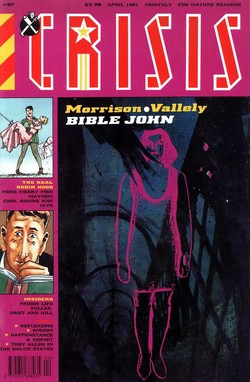
"Bible John - A Forensic Meditation" is a creator-owned British comic story. It was originally published in the adult-orientated comic Crisis between May and August 1991. Written by Grant Morrison with art by Daniel Vallely, the story is a multimedia study of the unsolved Bible John murders carried out in Glasgow in the 1968 and 1969.
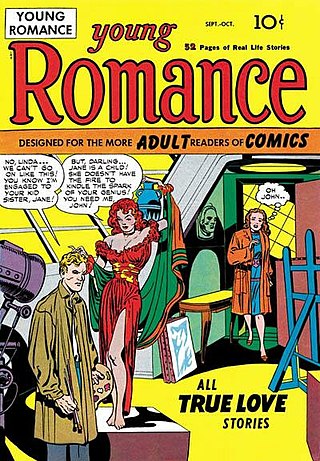
Romance comics are a genre of comic books that were most popular during the Golden Age of Comics. The market for comics, which had been growing rapidly throughout the 1940s, began to plummet after the end of World War II when military contracts to provide disposable reading matter to servicemen ended. This left many comic creators seeking new markets. The romance comic genre was created by Joe Simon and Jack Kirby, who kicked off Young Romance in 1947 in an effort to tap into new adult audiences. In the next 30 years, over 200 issues of the flagship romance comic would be produced.
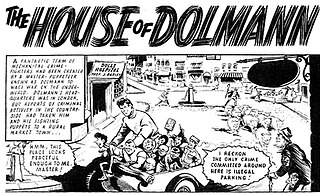
"The House of Dolmann" is a British comic strip published by Fleetway Publications and later IPC Magazines in the boys' comic anthology title Valiant between 29 October 1966 to 11 April 1970, with a brief revival from 7 September to 26 October 1974. Written by Tom Tully and primarily illustrated by Eric Bradbury, the strip centred on the exploits of genius inventor Eric Dolmann and his army of crime-fighting robot 'puppets'.

Princess Tina was a British weekly girls' comic anthology published by Fleetway Publications and IPC Magazines from 23 September 1967 to 12 January 1974. The comic was created by combining two underperforming Fleetway titles — Princess and Tina — into a third, new comic. Notable strips included the long-running family drama "The Happy Days" and "Patty's World". The latter would outlive Princess Tina, continuing after the comic was merged into Pink.
British girls' comics flourished in the United Kingdom from the 1950s through the 1970s, before beginning to decline in popularity in the 1980s and 1990s. Publishers known for their girls' comics included DC Thomson and Fleetway/IPC. Most titles appeared weekly, with the content primarily in picture-story format. The majority of the stories were serialized, with two or three pages per issue, over eight to twelve issues. They were marketed toward young teen girls.

Girls' Crystal was a British weekly fictional anthology publication aimed at girls. Published by Amalgamated Press and later Fleetway Publications from 26 October 1935 to 18 May 1963. Uniquely for an Amalgamated Press title, Girls' Crystal began as a story paper before transforming into a picture comic between editions, with the new format debuting on 21 March 1953. It ran for a combined total of 1432 issues before merging with School Friend in 1963.
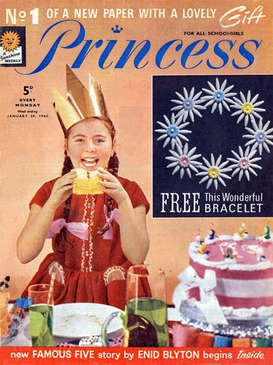
Princess was a British weekly girls' comic anthology published by Fleetway Publications and, later, IPC Magazines. The first version was published between 30 January 1960 and 16 September 1967, and featured a mix of comic strips, text stories and a large proportion of features; it was merged with Tina to form a new title - Princess Tina - after 399 issues.

June was a British weekly girls' comic anthology published by Fleetway Publications and IPC Magazines from 18 March 1961 to 15 June 1974. Designed as a response to DC Thomson's hit Bunty, June never quite eclipsed its Scottish rival but was nevertheless a success on its own terms, reaching 631 issues before being merged into Tammy in 1974.
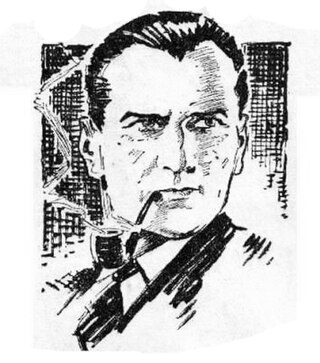
Dixon Hawke was a fictional detective who was featured in the DC Thomson publications from 1912 to 2000. Created in 1912 by an unknown author for DC Thomson he appeared in various publications including The Saturday Post, The Sunday Post, Adventure, The Sporting Post, Topical Times, The Evening Telegraph and The Dixon Hawke Library.
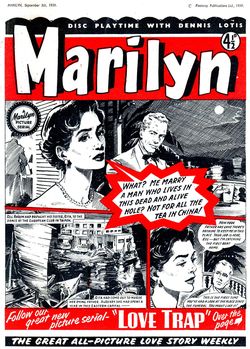
Marilyn was a British girls romance comic published weekly by Amalgamated Press and Fleetway Publications between 19 March 1955 and 18 November 1965. It ran for between 547 and 549 issues before merging with Valentine.

Valentine was a British girls romance comic published weekly by Amalgamated Press, Fleetway Publications and IPC Magazines between 19 January 1957 and 9 November 1974. It ran for 922 issues before merging with Mirabelle.

Roxy was a British girls romance comic published weekly by Amalgamated Press and Fleetway Publications between 15 March 1958 and 14 September 1963. It ran for 288 issues before merging with Valentine.
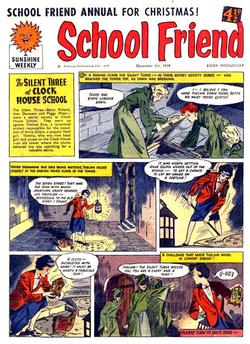
School Friend was a British weekly girls' comic anthology published by Amalgamated Press and Fleetway Publications from 20 May 1950 to 23 January 1965. Considered the first British girls' comic and bearing the same name as a popular story paper previously published by Amalgamated Press, School Friend was a huge success and effectively kickstarted the genre in British publishing.
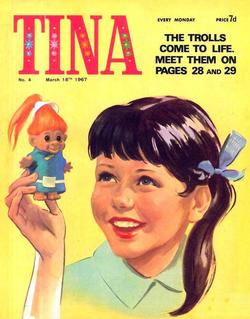
Tina was a British weekly girls' comic anthology published by Fleetway Publications from 25 February to 16 September 1967. The title was created specifically to be syndicated by a consortium of European publishers, and was particularly successful in the Netherlands. However, it struggled to make a mark in the British domestic market, and after 40 issues was merged with Princess to create successor title Princess Tina.


















